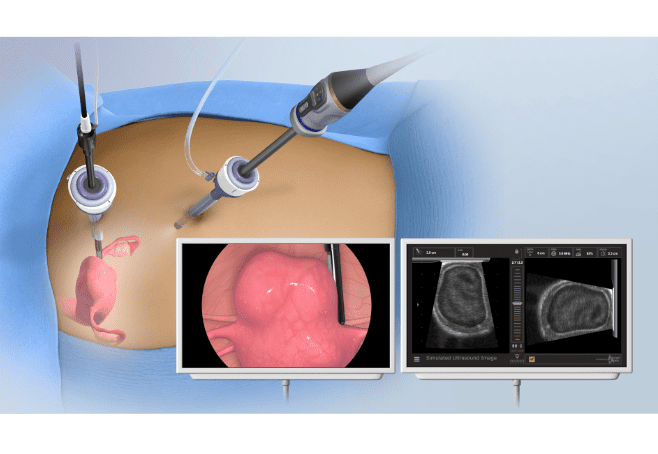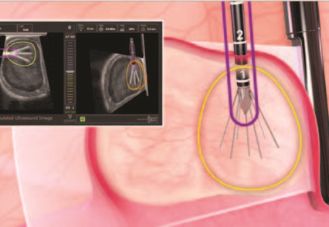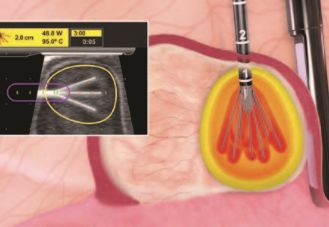Gynesonics' Sonata system is a transcervical procedure for symptomatic uterine fibroids, expanding our minimally invasive treatment options for fibroids and abnormal uterine bleeding.





in the news
Check out our Newsroom for the latest news coverage on the Acessa procedure and other innovations.
ACOG updated PB228 supporting the use of Lap-RFA – like the Acessa® procedure – as a minimally invasive uterine fibroid treatment option.
The Acessa ProVu® system is advancing fibroid treatment.
The simple solution women and OBGYNs have been waiting for.
Extensive. Enhanced. Effective. Engaged.
Help Her Find Relief
Unlike many alternative interventions, the Acessa® procedure allows for a full view of the pelvic anatomy by simultaneously displaying the lap camera view and the ultrasound view in real time, so you can easily locate and target nearly all types of fibroids, including intramural.²




Listen to Viwena's Acessa story
Procedure Overview
The Acessa procedure uses controlled radio frequency energy (heat) to cause coagulative necrosis of the fibroid tissue. The treated tissue softens and shrinks over time, allowing fibroid symptoms to resolve without difficult and time consuming uterine suturing.1

PREP AND ACCESS
A minimum of 3 incisions are made for a 5 mm laparoscope, 10 mm ultrasound probe, and a percutaneous insertion of the Acessa handpiece.2

VISUALIZE
Laparoscopic and intra-abdominal ultrasounds locate fibroids, visualize anatomy, and confirm safety.

DEPLOY
The Acessa handpiece tip is inserted into a fibroid and the 7 needle-like arrays are deployed. The system automatically calculates the dimensions of the treatment zone and the duration of the ablation.

TREAT
Radiofrequency energy is emitted through the arrays; the heat generated from the radiofrequency energy causes thermal destruction of the fibroid through coagulative necrosis.²
Visual and temperature cues enable confirmation that the fibroids are fully treated before finishing the procedure.
Patient Marketing Materials
In addition to bringing you best-in-class technology and support, Hologic has developed an online portal for Patient Outreach Toolkit providing you with ready-to-print and downloadable materials to help streamline your patient outreach and education initiatives.
Feature
Visit Our Virtual Surgery Suite
See how our products work in a three-dimensional surgery suite.
Important Safety Information
The Acessa ProVu system is indicated for use in percutaneous, laparoscopic coagulation and ablation of soft tissue, including treatment of symptomatic uterine fibroids under laparoscopic ultrasound guidance. The Acessa ProVu system is contraindicated for patients who are not candidates for laparoscopic surgery and/or patients with a uterus adherent to pelvic tissue or viscera. The Acessa ProVu system’s guidance system is not intended for diagnostic use. Please read all instructions for use of the Acessa ProVu system prior to its use. Safe and effective electrosurgery is dependent not only on equipment design but also on factors under control of the operator. Rare but serious risks include, but are not limited to, skin burns, mild inter-operative bleeding, post-procedural discomfort (cramping, pelvic pain), infection, vaginal bleeding, blood loss and complications related to laparoscopy and or general anesthesia. If you or someone you know has possibly experienced a side effect when using our product please contact your physician. Insufficient data exists on which to evaluate the safety and effectiveness of the Acessa ProVu system in women who plan future pregnancy, therefore the Acessa ProVu system is not recommended for women who are planning future pregnancy.
1. Havryliuk Y, Setton R, Carlow JJ, Shaktman BD. Symptomatic Fibroid Management: Systematic Review of the Literature. JSLS. 2017;21(3): e2017.00041. doi:10.4293/JSLS.2017.00041
2. Chudnoff SG, Berman JM, Levine DJ, Harris M, Guido Rs, Banks E. Outpatient procedure for the treatment and relief of symptomatic uterine myomas. Obstet Gynecol. 2013;121(5):1075-1082. doi:10.1097/AOG.0b013e31828b7962
